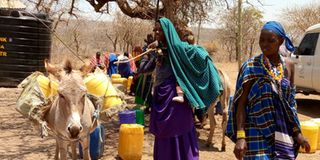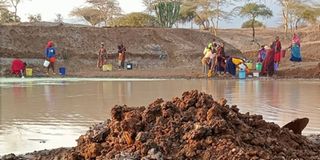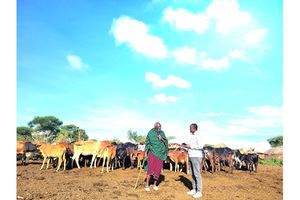
Arusha. “I don’t even want to remember...” begins Ms Naserian Mebukori, recalling the devastating impact of climate change on her community in Monduli District, Arusha Region.
Asked about the current water situation in her area, Ms Mebukori looked skyward, drew a deep breath, and began recounting a harrowing tale of how drought has disproportionately affected Maasai women and children in their villages.
Now 63, Ms Mebukori married into the Nanja area of Monduli 44 years ago and is a mother of 11. She shared the deep scars left by prolonged drought on access to water.
“The drought that struck our district last season plunged the community into panic. Everyone turned to their faith, believing the end was near,” she said.
“Our greatest struggle was the lack of drinking water and water for domestic use. Every source dried up—what remained was just dust,” she added.
She noted that the drought also led to the mass death of livestock, worsening the crisis, as the Maasai depend heavily on animals for food and income.
In desperate pursuit of water, women were forced to rise at midnight and walk between 15 and 20 kilometres.
“In our pastoralist communities, it’s the woman’s role to fetch water. We had to carry our children and take donkeys with us to collect water,” said Ms Mebukori.

She explained that travelling in groups became essential for protection from dangerous wildlife—including elephants, lions, hyenas, and buffaloes—as well as from men who preyed on women during these treks.
“Some women and girls were sexually assaulted, but such matters are taboo. Speaking out risks stigma—from families, the community, even from husbands. Many choose silence,” she said.
A mother of seven from Losimingori Village, Ms Beatrice Laizer, 43, echoed these experiences. Having lived in the area for 25 years, she described the most recent drought as the worst.
“In earlier years, even when small dams dried up, the rain would return quickly to refill the bigger ones. But from 2021 to 2023, there was no rain,” she said.
The drought undermined livelihoods as women spent more time searching for water, limiting their ability to earn income by selling beadwork and other goods at markets. A lack of pasture also left livestock unable to survive.
“Even the water we fetched after walking long distances was dirty. We had to filter it using maize flour or ash to settle the mud,” she said.
“Wild animals were desperate, too. They invaded homes at night, broke fences to access stored water, or raided livestock shelters,” added Ms Laizer.
Ms Neema Lucas, 41, said the drought affected women giving birth, noting that the absence of water in health facilities instructed expectant mothers to bring five-litre containers for hygiene needs post-delivery.
Village leaders acknowledge the crisis
Nanja Village Chairman, Mr Yamati Kisiongo said more than 2,000 people were directly affected by the drought between 2021 and early 2024.
“Women and children were forced to walk day and night to fetch water, which was neither clean nor safe, but they had no choice,” he said.
Lepurko Village Chairman, Mr Lendo Mollel shared a similar account, saying their community, home to over 1,380 residents, relied entirely on Losikito Dam, which dried up and left residents in distress.
“Many men and boys had to migrate with livestock in search of pasture across regions, while women remained to care for the young and elderly,” said Mr Mollel.
He thanked the government for stepping in with food aid during the most critical phase of the drought.
Citizens call for lasting solutions
Losimingori Village Chairman, Mr Lazaro Laizer, appealed to the government to invest in durable dam infrastructure instead of temporary or open facilities.
“There should be protective fencing and proper water management systems to reduce loss and protect users from harm,” he urged.
The policy and legal framework
The 2002 National Water Policy recognises water as a basic human right and an economic resource that must be managed equitably and sustainably.
In addition, the Water Supply and Sanitation Act No. 11 of 2009 guarantees every citizen the right to access clean and safe water for domestic use.
Tanzania’s National Development Goals for 2020-2025 set a target of 95 percent water coverage in urban areas and 85 percent in rural areas by December 2025.
However, rural coverage has reached 79.6 percent, while urban areas are just under 90 percent.
Response from govt and development partners
Lepurko Councillor, Mr Yonas Masiaya said formal requests were submitted to the government for support in rehabilitating critical dams.
“The government has begun the work, including emergency repairs on Nanja Dam. A total of Sh337 million has been spent to ensure over 50,000 residents get water services,” he said.
In collaboration with the United Nations Development Programme (UNDP) and local NGO FELOCI, the council is also mapping and protecting natural springs that retain residual moisture, aiming to restore them as sustainable water sources.
The Rural Water Supply and Sanitation Agency (Ruwasa) manager for Monduli District, Mr Neville Msaki, said eight out of the district’s 62 villages were severely affected.
Emergency funds of Sh100 million were used to distribute water to the most vulnerable communities, including Arkatan, Arkaria, Mti Mmoja, Nanja, Lepurko, Losimingori, Engaroji, and M’buyuni.
Mr Msaki noted that Monduli has more than 90 water sources—including springs, rivers, wells, and 64 dams. However, 61 dams dried up during the drought, leaving only three in operation.

In urban areas, water availability fell from four million litres per day to just 2.5 million—against a requirement of six million litres—creating a daily shortfall of 3.5 million litres, according to him.
He said the government is now prioritising the rehabilitation of major dams in Sonimel, Engarooji, Lesimingori, Lemooti, and Moita villages, with an emphasis on increasing storage capacity to last over a year.
New boreholes are also being drilled, and rainwater harvesting systems are being established to strengthen long-term resilience.
A permanent solution on the horizon
Mr Msaki revealed that the government is implementing a Sh520 billion water supply project, with Sh20 billion allocated to bring water from Arusha to Monduli. The initiative is expected to serve 13 villages.
“This project will finally resolve Monduli’s water crisis once and for all,” he said.

